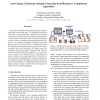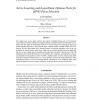34 search results - page 1 / 7 » A Logarithmic Time Method for Two's Complementation |
ICCS
2005
Springer
13 years 10 months ago
2005
Springer
This paper proposes an innovative algorithm to find the two’s complement of a binary number. The proposed method works in logarithmic time (O(logN)) instead of the worst case li...
CVPR
2012
IEEE
11 years 7 months ago
2012
IEEE
We propose a method of clustering images that combines algorithmic and human input. An algorithm provides us with pairwise image similarities. We then actively obtain selected, mo...
ICDE
2012
IEEE
11 years 7 months ago
2012
IEEE
—On a stream of two dimensional data items (x, y) where x is an item identifier, and y is a numerical attribute, a correlated aggregate query requires us to first apply a selec...
PKC
2010
Springer
13 years 3 months ago
2010
Springer
The Pollard kangaroo method solves the discrete logarithm problem (DLP) in an interval of size N with heuristic average case expected running time approximately 2 √ N group opera...
NLE
2008
13 years 4 months ago
2008
For complex tasks such as parse selection, the creation of labelled training sets can be extremely costly. Resource-efficient schemes for creating informative labelled material mu...


